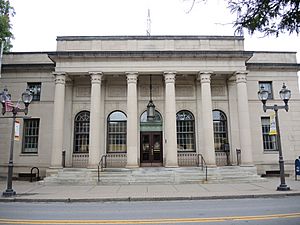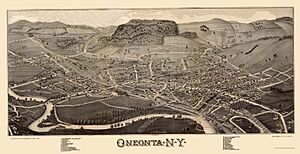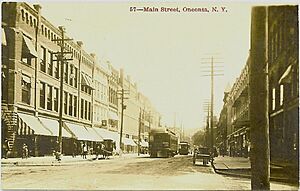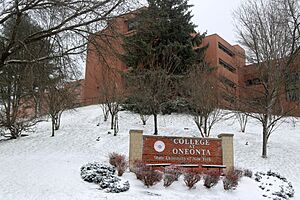Oneonta, New York facts for kids
Quick facts for kids
Oneonta
|
|
|---|---|
|
City
|
|

City Hall (formerly the post office)
|
|
| Nickname(s):
"City of the Hills"
|
|
| Country | United States |
| State | New York |
| County | Otsego |
| Region | Appalachian Region |
| Incorporated (village) | 1842 |
| Incorporated (city) | 1908 |
| Government | |
| • Type | Mayor-Council |
| Area | |
| • Total | 4.36 sq mi (11.31 km2) |
| • Land | 4.36 sq mi (11.30 km2) |
| • Water | 0.00 sq mi (0.01 km2) |
| Population
(2020)
|
|
| • Total | 13,079 |
| • Density | 2,999.08/sq mi (1,157.88/km2) |
| ZIP codes |
13820
|
| Area code(s) | 607 |
| FIPS code | 36-54881 |
Oneonta (/ˌoʊniˈɒntə/ OH-nee-ON-tə) is a city in southern Otsego County, New York, United States. It's sometimes called the "City of the Hills." Oneonta is home to two colleges: the State University of New York at Oneonta (SUNY Oneonta) and Hartwick College.
SUNY Oneonta started as a school for teachers in 1889. Hartwick College moved to the city in 1928. Many students from these colleges live in Oneonta. In 2020, about 13,079 people lived in the city. The name "Oneonta" might mean "place of open rocks" in the Mohawk language. This refers to a cool rock formation called "Table Rock" at the west end of the city.
The city of Oneonta is surrounded by the separate Town of Oneonta. The Oneonta Municipal Airport (N66) is located north of the city.
Contents
Oneonta's History
Long ago, Algonquin and Iroquoian-speaking Native American groups lived in the area where Oneonta is now. The Iroquois Confederacy was a powerful group of five nations before the 1400s. They were here when the first French and Dutch explorers arrived.
The first European settlers came to the area around 1775. They were mainly German and Dutch families moving from other parts of New York. Henry Scramling was one of the first settlers. He moved here around 1773 and started a farm near the Otego Creek.
In 1779, General James Clinton's army passed through this area. They were on their way to fight against Iroquois settlements.
The first small settlement, or hamlet, started around 1800 and was called "Milfordville." In 1830, the larger Town of Oneonta was created. Milfordville changed its name to Oneonta in 1832. In 1848, it became an official village within the Town.
In the mid-1800s, the Albany & Susquehanna Railroad came to Oneonta. This was a big deal! The railroad helped Oneonta grow into an important center for trains. It even had one of the largest locomotive roundhouses (a building for turning and storing trains) in the world.
Oneonta officially became a city in 1908. In 1991, Oneonta, New York, and Oneonta, Alabama, became "sister cities."
Oneonta's Location and Landscape
Oneonta is located at 42°27′21″N 75°3′44″W / 42.45583°N 75.06222°W. It covers about 4.4 square miles (11.3 square kilometers) of land.
The city is situated between two larger cities: Binghamton and Albany.
The Susquehanna River flows west past the southern part of the city.
Major roads like Interstate 88, New York State Route 7, New York State Route 23, and New York State Route 28 all pass through Oneonta.
Oneonta's Buildings and Architecture
Oneonta has many different kinds of buildings. You can see Victorian-style homes and commercial buildings from the 20th century. Because of its location, Oneonta doesn't have many large factories or industrial areas.
Several historic buildings in Oneonta were once homes of important people.
- The Fairchild Mansion was the home of George Winthrop Fairchild. He was one of the founders of IBM, a famous technology company. This mansion was added to the National Register of Historic Places in 1974.
- The George I. Wilber House is another historic home. It was built in two parts, around 1875 and 1890. It's a large, fancy wooden house with a round tower and a decorative porch. Today, it's home to the Community Arts Network of Oneonta.
Other buildings and areas in Oneonta are also listed on the National Register of Historic Places. This means they are important for their history or design. Some of these include:
- Bresee Hall
- Chapin Memorial Church
- Ford Block
- Municipal Building
- Oneonta Armory
- Oneonta Theatre
- Old Post Office
The tallest building in Oneonta is Nader Towers. It's nine stories high and provides housing for senior citizens.
Oneonta's Population
| Historical population | |||
|---|---|---|---|
| Census | Pop. | %± | |
| 1870 | 1,061 | — | |
| 1880 | 3,002 | 182.9% | |
| 1890 | 6,272 | 108.9% | |
| 1900 | 7,147 | 14.0% | |
| 1910 | 9,491 | 32.8% | |
| 1920 | 11,582 | 22.0% | |
| 1930 | 12,536 | 8.2% | |
| 1940 | 11,731 | −6.4% | |
| 1950 | 13,564 | 15.6% | |
| 1960 | 13,412 | −1.1% | |
| 1970 | 16,030 | 19.5% | |
| 1980 | 14,933 | −6.8% | |
| 1990 | 13,954 | −6.6% | |
| 2000 | 13,292 | −4.7% | |
| 2010 | 13,901 | 4.6% | |
| 2020 | 13,079 | −5.9% | |
| U.S. Decennial Census | |||
In 2000, about 13,292 people lived in Oneonta. The city had 4,253 households. About 22% of households had children under 18. The average age of people in Oneonta was 23 years old.
Education in Oneonta
Oneonta is a city with a strong focus on education. It is home to two colleges:
- SUNY Oneonta: This college started in 1889. About 5,800 students attend SUNY Oneonta.
- Hartwick College: This college moved to Oneonta in 1928. About 1,500 students attend Hartwick College.
The students from these colleges make up a large part of Oneonta's population.
The Oneonta City School District (OCSD) serves students from Oneonta and nearby towns. The district includes:
- Oneonta High School: This high school has about 650 students.
- Oneonta Middle School: This middle school has about 300 students.
- Three elementary schools: Greater Plains, Riverside, and Valleyview. These schools have about 900 students in total.
Parks and Fun in Oneonta
The city of Oneonta has two main parks for everyone to enjoy: Neahwa Park and Wilber Park.
Damaschke Field is located in Neahwa Park. It's a baseball field where the Oneonta Outlaws team plays. They are part of the Perfect Game Collegiate Baseball League (PGCBL).
Oneonta used to have a minor league baseball team called the Oneonta Tigers. They played from 1967 to 2010.
Transportation in Oneonta
Interstate 88 runs along the edge of the city. New York State Route 7 and New York State Route 23 go through the middle of Oneonta. These roads help people travel to and from the city.
Oneonta's Centennial Celebration
In 2008, the city of Oneonta celebrated its 100th birthday! They had special events throughout the year to mark this important milestone.
Famous People from Oneonta
Many interesting people have connections to Oneonta:
- Scott Adams: The cartoonist who created Dilbert went to Hartwick College.
- Clay Bellinger: A former professional baseball player was born and grew up here.
- Wendell Brown: An entrepreneur and inventor, he graduated from Oneonta High School.
- George Winthrop Fairchild: A businessman and chairman of IBM, he was born in Oneonta.
- Sherman Mills Fairchild: An inventor, he was also born in Oneonta.
- Henry E. Huntington: A railroad leader and developer of Beverly Hills, California, was born in Oneonta.
- Jim Konstanty: A baseball pitcher, he was an athletic director at Hartwick College.
- Mark May: A professional football player and sportscaster, he was born here and graduated from Oneonta High School.
- Bill Pullman: An actor, he earned his theater degree from SUNY Oneonta.
- Paul Reubens: The actor famous for playing Pee-wee Herman, spent part of his childhood in Oneonta.
- Jack Smith: A lawyer, he received his degree from SUNY Oneonta.
- Jerry Jeff Walker: A country music singer, he was born in Oneonta.
See also
 In Spanish: Oneonta (Nueva York) para niños
In Spanish: Oneonta (Nueva York) para niños






